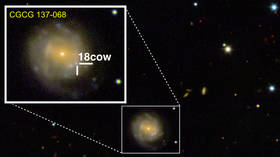Epic ‘stellar explosion’ captured on camera points to birth of a black hole (PHOTO)

Thanks to an international effort involving some of the most advanced satellite and land-based telescopes ever developed, scientists believe they may have witnessed the birth of a black hole for the first time.
The Hawaii-based ATLAS telescope first spotted what would later be dubbed ‘The Cow’ on June 16, 2018. This celestial detonation was an “unprecedentedly bright and rapidly evolving stellar explosion” the likes of which had never been seen before, so much so, that teams across the globe immediately pointed their telescopes at this “space engine” located in a galaxy 200 million light years away.
Team of telescopes including @ESA_Integral & @ESA_XMM finds the X-ray engine inside AT2018cow – aka ‘the #Cow’ – an unprecedented #supernova explosion first spotted in June last year ⭐️💥🐮Full story: https://t.co/pvSiNN41Pf#astronomy#aas233📷⬇️@keckobservatorypic.twitter.com/Cmg0IYttc8
— ESA Science (@esascience) January 10, 2019
Just two days after hordes of astronomers the world over pointed their space- and ground-based telescopes at the mysterious celestial ‘cow’, they realized this was a far from ordinary supernova: in a matter of days it had outshone anything previously observed in the history of astronomy, between 10 and 100 times brighter than any supernova observed by human instrumentation. It reached peak luminosity in a matter of days, not weeks.
Key data and images were pulled thanks to the combined efforts of ESA’s Integral and XMM-Newton, as well as NASA’s NuSTAR and Swift space telescopes, which altogether cover the length and breadth of the observable energy spectrum almost entirely.
“Integral covers a wavelength range which is not covered by any other satellite,”says Erik Kuulkers, Integral project scientist at ESA. “We have a certain overlap with NuSTAR in the high-energy X-ray part of the spectrum but we can see higher energies, too.”
A supernova is the death of an old star in which a massive explosion which sends vast quantities of ‘star stuff’ far and wide throughout the surrounding solar system, giving off vast amounts of both high and low energy x- and gamma rays in the process. In this case, researchers believe the outburst marked the formation of either a nascent black hole or neutron star with a powerful magnetic field, sucking in the surrounding material.
“The most exciting interpretation is that we might have seen for the first time the birth of a black hole or a neutron star,” says Raffaella Margutti of Northwestern University, USA, lead author of the new paper detailing the ESA’s findings.
Also on rt.com Aliens phoning home? Mysterious deep-space radio signals are more frequent than we thought“We know that black holes and neutron stars form when stars collapse and explode as a supernova, but never before have we seen one right at the time of birth,” adds co-author Indrek Vurm of Tartu Observatory, Estonia, who worked on modelling the incredible event.
Think your friends would be interested? Share this story!














